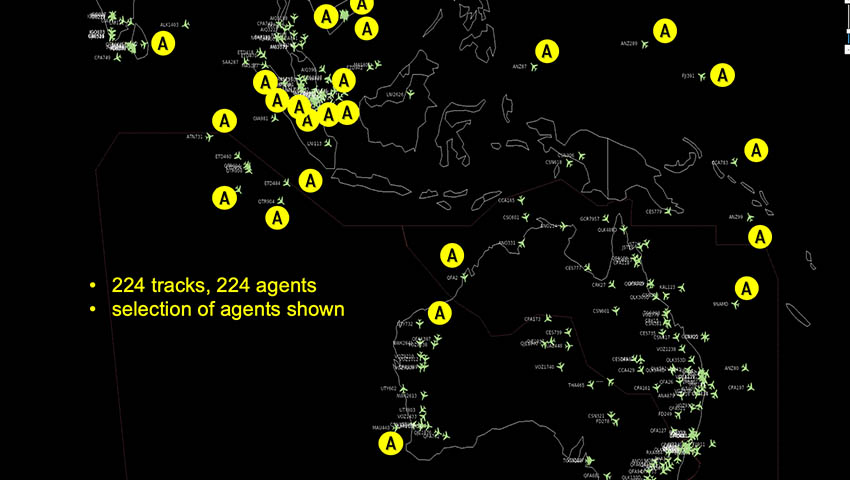Air Force Headquarters has identified artificial intelligence as one of the key developing technologies that will enhance the capability of Australia’s Air Surveillance Operators (ASOPs) and Air Battle Managers (ABMs) ahead of AIR 6500.
To continue reading the rest of this article, please log in.
Create free account to get unlimited news articles and more!
Australia’s ASOPs and ABMs perform nationally important roles – to detect and then rapidly and effectively respond to air threats. With a range of emerging ballistic and tactical missile systems, the pace of operations and complexity of threats is increasing.
ASOPs and ABMs already work in a critical, high-workload, high-stress environment, with few contemporary decision support tools. In the near future they will experience a substantially increased operational intensity. Consequently, there is the potential for them to become overwhelmed, unable to process the available information at the rate needed to make well informed tactical decisions.
Agent Oriented Software (AOS), an Australian AI company, recently completed the development of a proof-of-concept, AI-based decision aid, the Intelligent Battlespace Advisor, or IBA, to support ASOPs. It does this by accessing the vast amount of incoming data from various sources, correlating this, and alerting the operators to anomalous behaviour. This was sponsored by Air Force Headquarters, and with funding from the Defence Innovation Hub.
The AIR 6500 program is an ambitious ADF program to create the underpinning architecture for an integrated air and missile defence (IAMD) system – in 2019 a number of key decisions will be made on the way forward.
AIR 6500 will provide a Joint Air Battle Management System (JABMS) to link the many disparate platforms, systems and sensors across air, land, maritime, space, ESM and cyber domains. IBA has the potential to provide the JABMS with a new generation of decision support.
The IBA has two modules: the Surveillance Advisor for ASOPs; and the ABM Response Advisor supporting the ABM team.
The IBA Surveillance Advisor, demonstrated to 41 WG and 42 WG at Williamtown, and to AFHQ in 2018, is designed as an intelligent assistant, to assist ASOPs and intelligence analysts to more effectively identify all contacts within the battlespace. The IBA Surveillance Advisor autonomously conducts a comprehensive intelligence assessment of every track against a number of existing real-time databases and online information streams. The IBA interrogates these data sets, continuously correlating information to identify tracks that are anomalous and potentially hostile.
Where the IBA Surveillance Advisor discovers inconsistencies in data, the ASOP is alerted. This alert is tagged against the specific track and includes a summary of the IBA’s findings. The IBA emulates certain skills that an experienced operator possesses, while providing an additional overlay of certainty that all available information will be applied to the mission in real time.
IBA offers 'personalised' attention to every track detected, and unlike a human it doesn’t lose concentration, so no track is overlooked. Intelligent software agents continuously monitor the aircraft performance and immediately notice, and can alert the operator, if there is a deviation e.g. an aircraft apparently routinely on track, suddenly descending rapidly due to a depressurisation.
The ASOP’s concentration is then focused solely on the 'outliers', without the need to constantly switch their focus of attention between “scans” of the situation and resolving unexplained tracks.
One Defence expert commented on the IBA Surveillance Advisor, saying, "The IBA also demonstrated the ability to incorporate a broad range of unclassified sources of data, of different type and format, to enable the identification of these anomalies. A tool of this type, if incorporated into an ABM C2 system, and developed to the level that AOS wish to achieve, could produce significant gains in the role efficiency for those performing the surveillance role."
The next IBA developmental step has two concurrent streams: an enhanced version of the Surveillance Advisor integrated with the Solypsis TDF graphical user front end, currently used by Vigilare. The second step is the development of the Response Advisor.
Currently, the actions required to respond to an intruder are performed manually by the ABMs. They receive real-time updates from the aircraft (via Link 16), monitoring the Recognised Air Picture, planning and modifying the air-to-air (AAR) refuelling schedule, and determining the response.
"AOS’s employment of an agent-based approach is unique amongst the decision support tools that RAAF has been exposed to so far. All other such tools that have been demonstrated to … are reliant upon a combination of real-time information and a database of stored, previously captured data. The agent-based approach appears to provide some advantages, in its lack of requirement for stored data, and an ability to still provide decision support in situations that are dissimilar from those previously observed and catalogued," the Defence expert explained.
The IBA Response Advisor will assist the ABMs to manage the aircraft on CAP, to ensure a persistent CAP within an area of operations. When intruders are detected, it will support the ABMs to assess the tactical situation, suggest the intruders’ potential intentions, and assist the ABMs to select a feasible combined response, within the time constraints.
The IBA Response Advisor planner needs to support the human, generating response options that take into account resources, standard operating procedures, and both hard and soft constraints, presenting the ABM with options as to what plans are feasible, leaving them to choose the best one. Then, when time-critical re-planning is necessary, the system must incorporate all these factors, plus the current commitments, as it generates a revised set of options.
Stephen Kuper
Steve has an extensive career across government, defence industry and advocacy, having previously worked for cabinet ministers at both Federal and State levels.

 Login
Login








